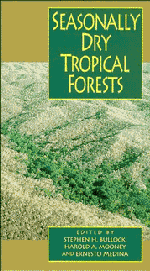Book contents
- Frontmatter
- Contents
- List of contributors
- Acknowledgements
- 1 Introduction
- 2 Dry forests of Central America and the Caribbean
- 3 Overview of the Brazilian caatinga
- 4 Savannas, woodlands and dry forests in Africa
- 5 Dry forest ecosystems of Thailand
- 6 The Cenozoic record of tropical dry forest in northern Latin America and the southern United States
- 7 Diversity and floristic composition of neotropical dry forests
- 8 Vertebrate diversity, ecology and conservation in neotropical dry forests
- 9 Diversity of life forms of higher plants in neotropical dry forests
- 10 Drought responses of neotropical dry forest trees
- 11 Plant reproduction in neotropical dry forests
- 12 Plant–herbivore interactions in Mesoamerican tropical dry forests
- 13 Biomass distribution and primary productivity of tropical dry forests
- 14 Nutrient cycling in tropical deciduous forests
- 15 Biology of the belowground system of tropical dry forests
- 16 Nitrogen trace gas emissions in a tropical dry forest ecosystem
- 17 Conversion of tropical dry forest to pasture and agriculture
- 18 Ethnobotany of the Mexican tropical dry forests
- Index
4 - Savannas, woodlands and dry forests in Africa
Published online by Cambridge University Press: 07 September 2010
- Frontmatter
- Contents
- List of contributors
- Acknowledgements
- 1 Introduction
- 2 Dry forests of Central America and the Caribbean
- 3 Overview of the Brazilian caatinga
- 4 Savannas, woodlands and dry forests in Africa
- 5 Dry forest ecosystems of Thailand
- 6 The Cenozoic record of tropical dry forest in northern Latin America and the southern United States
- 7 Diversity and floristic composition of neotropical dry forests
- 8 Vertebrate diversity, ecology and conservation in neotropical dry forests
- 9 Diversity of life forms of higher plants in neotropical dry forests
- 10 Drought responses of neotropical dry forest trees
- 11 Plant reproduction in neotropical dry forests
- 12 Plant–herbivore interactions in Mesoamerican tropical dry forests
- 13 Biomass distribution and primary productivity of tropical dry forests
- 14 Nutrient cycling in tropical deciduous forests
- 15 Biology of the belowground system of tropical dry forests
- 16 Nitrogen trace gas emissions in a tropical dry forest ecosystem
- 17 Conversion of tropical dry forest to pasture and agriculture
- 18 Ethnobotany of the Mexican tropical dry forests
- Index
Summary
Introduction
In Africa, the term dry forest covers vegetation types dominated by a more or less continuous tree cover (70%), experiencing pronounced drought during more than three months per year, and occurring within the savanna biome. They may be called (open) woodlands or (dense) dry forests according to tree density and understory structure (Menaut 1983). The Yangambi classification establishes the following (Boughey, 1957a, b; Monod, 1963; Aubréville, 1965).
A woodland has an upper stratum of deciduous trees of small or medium size, with their crowns more or less touching above a sparse woody understory. Tree density is high enough to affect the herbaceous stratum which differs floristically from the adjacent savanna. The ground layer consists of grasses, herbs and suffrutescent plants in sufficient density to allow for annual burnings. The canopy of a woodland tends to be dominated by one or very few species.
A dry forest, strictly speaking, is defined as a closed stand with several woody strata. The grass layer, when present, is weak and discontinuous, only allowing for episodic and sparse fires. In most cases, the trees of the upper stratum are deciduous whereas the understory is composed of evergreen and/or deciduous shrubs which differ from the canopy floristically. The canopy is multispecific and often devoid of woodland dominants. In both dry forest and woodland, the tree species which make up most of the canopy are present but never dominant in the surrounding savanna.
Some authors have considered dry forests to be a tropophilous extension of the rain forest, with adaptations to xeric conditions in characteristics of stems but not of leaves (Schnell, 1976–7).
- Type
- Chapter
- Information
- Seasonally Dry Tropical Forests , pp. 64 - 92Publisher: Cambridge University PressPrint publication year: 1995
- 40
- Cited by



